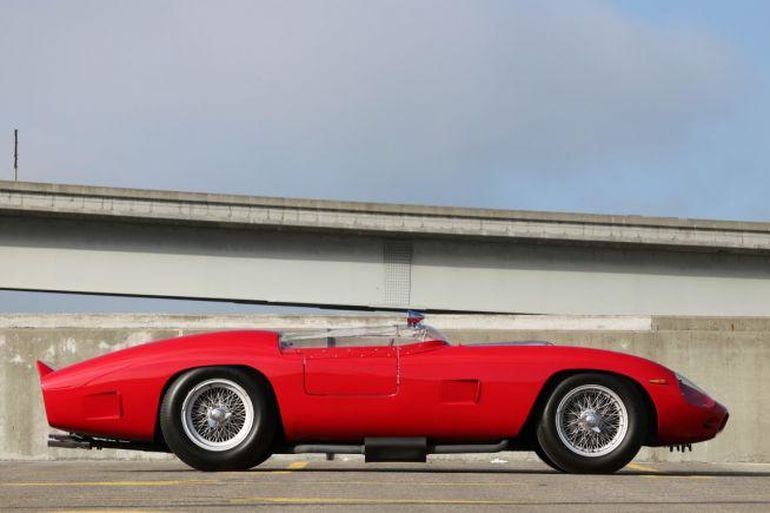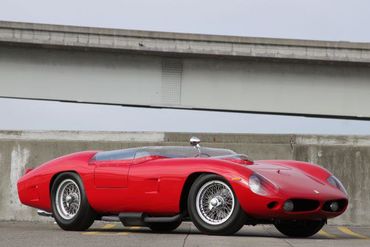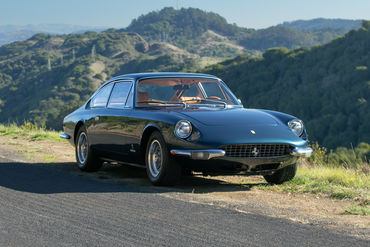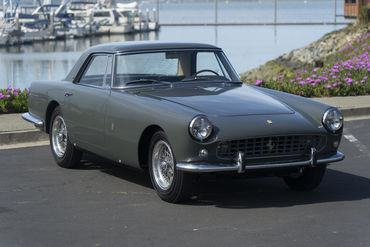Sold
SOLD 03/17
1961 Ferrari
TR61 Reconfiguration with Scaglietti Coachwork
Aluminum Reconfiguration by Mark Gerisch For a Famous Seattle Ferrari Collector Utilizing All Ferrari Components.
- VIN13123
- Exterior ColorRosso Corsa
- Interior ColorBlue Cloth
- MileageTMU
- Engine3.0 Litre 12-Cylinder (tipo 128)
- Engine no.4915, internal no. 536/62E
- Transmission5-Speed Manual
- StatusSold
- StockFJ1913
Description
1961 Ferrari 250 TR61 Reconfiguration
s/n 13123, Engine no. 4915
Rosso Corsa with Blue Cloth Interior
For the 1961 racing season Ferrari continued the development of the tried and trusted 250 TR for yet another year despite an increasing number of competing teams having adopted mid-engine layouts. However, the new for 1961 250 TRI61 did represent a significant step forward with regards to areodynamics since the introduction of the three-litre Testarossa back in 1957. A driving force behind the newly acquired “Sharknose” appearance of the TR61 was Ferrari’s chief engineer Carlo Chiti, who had insisted a wind tunnel should be installed in the factory. After a temporary, small scale tunnel was tried early in 1960, a more permanent and larger wind tunnel was completed before the end of the year. Among the first lessons learned by this more scientific approach was applied to one of the two TR61s built. Although more developed under the skin, the 1960 TR still featured an evolution of the body used for all the works cars since 1958. Initially, the work focused on the rear half of the car where a much taller tail was fitted complete with a cut-off “Kamm” tail.
The experimental tail was carried straight over to the 250 TRI61 as it was found to reduce drag, while also increasing the downforce generated thanks to a small spoiler mounted on the very edge of the tail. The latest Testarossa was fitted with a steeply raked, wrap-around windscreen, which was barely taller than the rear deck. Featuring a striking “Sharknose” style split front air-intake; the very slippery TRI61 was considerably longer and somewhat more angular, when compared to its predecessors. Despite the increase in size, it was actually also quite a bit lighter.
Like the 1960 Testarossa, the TR61 featured a sophisticated space frame constructed from smaller diameter, lighter steel tubes. The cars utilized an independent rear suspension system first introduced in 1960. Larger disc brakes were fitted front and rear. The red-headed 3.0L V12 powerplant was mated to a five-speed gearbox. The bodies were designed by Fantuzzi, but built by Scaglietti in lightweight aluminum, with a lightweight steal sub-suport system. The Ferrari factory only produced two cars in the TR61 configuration; s/n 0792TR and 0794TR, with a third car, s/n 0782TR ultimately converted over to TR61 configuration from TR60 of the previous year.
Although few in numbers, the cars were immensely successful in competition. s/n 0792TR won the 12 Hours of Sebring overall in 1961 and 1962 with Phil Hill/Olivier Gendebien and Joakim Bonnier/Lucien Bianchi driving, respectively. After a rebody in in-house, s/n 792TR went on to victories at Auvergne and Reims. The sister car captured what is surely the crown jewel of the TR61 historical accomplishments; an overall victory at the 24 hours of Lemans with works drivers Phil Hill and Olivier Gendebien at the controls. Unfortunately, later in s/n 0794TR’s period history the car sustained significant damage in a racing accident at Cotati in California, and was off the road for many years prior to being restored to Pebble Beach Standards. s/n 0792TR, after also sharing a period of North American racing history (with Pedro Rodrigues), has also undergone a top caliber restoration including a rebody back to original TR61 configuration. Curiously, s/n 0782TR is thought to have been sold to Australia sometime after 1962, but it is yet to surface.
This particular reconfiguration is an amalgamation of Ferrari components assembled to its present form between 1991 and 1994. It is based around a standard Ferrari 250GT V12 powerplant (no. 4915, internal number 536/62E), with a Ferrari transmission, differential, suspension parts, and braking system. The chassis is a small diameter steal spaceframe built by Mark Gerisch of M&L Auto Specialists in Wisconsin. The frame was constructed using factory plans for the TR61 (typo 526B) with the correct 2250mm wheelbase, and accurate suspension pick up point locations. The engine was rebuilt by Byron Sandborn of Vintage Racing Motors in Redmond, Washington using 250 Lusso heads (typo 168) and front timing cover (from s/n 4519). While the engine build is relatively mild, and it functions well on pump gas, slightly hotter cams were sourced from Bob Norwood, and six Weber 38DCN carburetors were fitted, exactly as originally produced. The engine features dry-sump lubrication, fitted with a DK Engineering unit. The front suspension, brakes, and front cross member carrying the chassis number stamping were all sourced from a Ferrari 365 GT. The car sits on correct-to-original 5.5 x 16 inch Borranis wire wheels; front (RW 3735, production date 7-60) and rear 6.5 x 16 inch wheels (RW 3334, production date 7-59). Mr. Garisch, who currently provides metalworking services to Wayne Obry’s Motion Productions has been the author of many Ferrari 250 recreations, and hand formed this exceedingly faithful all aluminum body. Standing next to the car, it is simply not possible to decipher from an original.
As is the case with many competition Ferraris today, the story behind how the parts found themselves is an interesting one. Engine no. 4915 (typo 128) seemed to be destined for spirited driving right from the start. Charlier/Mosbeaux, the original owners of 1963 Ferrari 250 GT s/n 4915, entered the car in an event a Spa Francoshamps when it was less than a year old. Although the car itself appears lost to historians, this engine later found its way to California and was offered by Barry Watkins along with Lusso heads and front timing cover case from s/n 4519, which received 330 GT engine no. 6555 in its place. This engine, along with Ferrari 365 GT brakes, cross member (s/n 13123), transmission, and differential from a core car were sourced out of the LA Times by Mark Garisch some 25 years ago now. After restoration, the car was raced at the Chicago Historic Races in Elkart Lake in 1994 by the previous owner for whom the car was configured, and it is featured in an article in Cavallino (issue no. 83, page 37).
Cosmetically and mechanically, the car is effectively as-new, with minimal usage since it was restored. There are a few minor hints of patina emerging, including the discoloration of the interior seat material, but the car presents beautifully and is fully operational mechanically, including air horns, indicators, and Marchal head and driving lamps. The engine bay and cockpit are both representative of a professional restoration and are exceedingly tidy. Likewise, the underside, largely covered by full body-length aerodynamic belly pans, is clean, dry, and very faithful to the original design. The car has been professionally maintained since restoration by Vintage Racing Motors for its owner, but has accumulated less than 1,000 miles, despite regular short drives to keep it exercised.
In 2015 the car was a fairly regular participant with Classic Sports Racing Group, competing in both the April David Love Memorial weekend where it could be found in a race long duel with Pontoon 250 Testarossa s/n 0754TR, and again in October in the Charity Challenge.
Included with the sale is an excellent documentation file including a historical summary of TR61’s, considerable photographic and printed documentation associated with the restoration of this particular example, as well as a roll over hoop and a second steering wheel in leather for use during historic racing events.
The Ferrari TR61 model was the last of the 250 Testarossas and among the most technically advanced of the front-engined Ferrari sports racers. With its low “Sharknose” and high rear bodywork, the TR61 preceded the look of the mid-engined cars that were to replace it. Restored to this configuration well over twenty years ago without regards to expense, and evocative of a magical era for sports car racing the world over, we cannot emphasize what a wonderful opportunity this TR61 reconfiguration represents. It is accurate down to the carburetor type, wheel sizes, and chassis dimensions; utilizing a Ferrari engine, transmission, differential, and suspension. Further, it is titled as a Ferrari, with road registration paperwork. Sadly, as each of the two original TR61s extant are likely valued in excess of $25 Million US today, they are an exceedingly rare sight at anything other than a static display venue. The only such reconfiguration known to us utilizing the correct 3.0L V12 Ferrari powerplant, this highly accurate TR61 is certain to add color and flavor to any top-tier motorsport gathering. The first Ferrari from an era where the power of aerodynamics were harnessed not only to increase straight-line speed, but also to improve handing, with the TR61, form follows function in the most elegant of packages.
Interesting offers invited.
Note: This car is titled as a 1970 Ferrari GT.
Photo credits: Dennis Grey, Alan Rosenberg
The above vehicle information is complete and accurate to the best of our knowledge at the time it is posted to this website. Corrections or additional information is always appreciated. All advertised prices exclude government fees and taxes, any finance charges, any dealer document preparation charge, and any emission testing charge. Vehicles are subject to prior sale. All advertised to be true but not guaranteed. We assume no liability for errors or omissions.
Inquire About This Car
Fantasy Junction • 510-653-7555 • 1145 Park Ave, Emeryville, CA 94608




